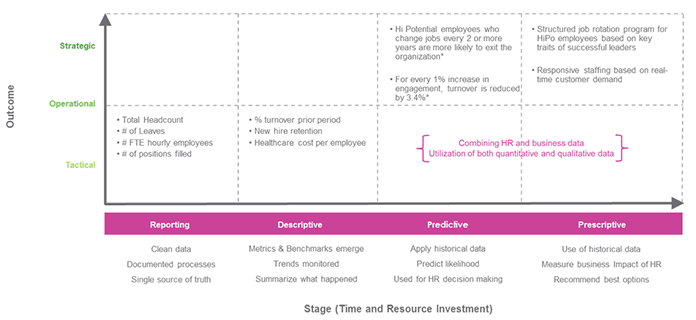by Dr. Michael Moon, People Insights Advisor with ADP
Everybody probably knows someone that just never managed to grow up. Even though their age might say something different, you can clearly see their maturity is not at the same level. Do you know people like that? Better yet, do you know companies like that?
For companies, being around for a long time or using data for a long time does not necessarily make you mature. What you do with that data and how it helps shape your business decisions is the real measure of your maturity.
The difference between age and maturity is a lot like the difference between data and analytics. Companies that use data may not necessarily be taking it to its full realization to uncover useful and actionable analytics for their business. To help illustrate the point, check out the HR Data and Analytics Maturity Model I created. This model shows the various levels of maturity an organization can gain in the use of both their HR and non-HR data.

So what is the difference between Data and Analytics Anyway?
Before we can dive into how exactly to create a mature HR organization, first you’ll have to understand some of the basics, starting with the difference between data and analytics. Here’s what you need to know.
Data–Data is either quantitative (numerical) or qualitative (non-numerical) information collected to answer questions or understand a situation. A statistic, in contrast, can only be numerical and represents other information like percentages or frequencies. Data can be also be qualitative information, which cannot always be assigned a number such as feedback on a questionnaire, suggestions for improvement, or a description of an employee’s skills or personality traits. The output of reports from our HR systems contain data.
Analytics–Analytics is the statistical analysis of collected data that reveals patterns, correlations, and sometimes, even cause-and-effect relationships, between different factors, or more simply put, it is the systematic analysis of data that leads to the discovery of meaningful patterns within data.
The results of the analysis can lead to insights into employee behavior, the efficacy of workplace policies and practices, and the value of human capital to company growth. Once HR professionals have a firm grasp of the analytics, they can begin to make more educated decisions about how they manage people and how to optimize HR processes. This helps answer not just the ‘what’ of a particular phenomenon but also the ‘why.’ Most importantly, analytics provide HR professionals with the vital tool they need to link the company’s human resources-including creativity, intellect, personality traits, life experiences, and attitudes-with its performance, profits, innovation, and reputation.
Just think of data as the building blocks of analytics-although you can glean insights from data alone, it’s the quantifiable results of analytics that can really drive decision-making and provide objective, verifiable links between talent and company performance that will wow management and lead to better business outcomes.
Achieving Analytics Maturity
When HR first takes a stab at using talent analytics for example, giving up is all too easy. So many of us think we need a data scientist, or to purchase a super expensive Business Intelligence tool, or in many cases, we just don’t know where to start. And while having the right tool for the right job is super important and ensuring you have good quality data is key, what HR really needs are people with strong financial and business acumen, HR domain expertise and the ability to take the data and analytics and craft it into a meaningful, compelling and actionable story.
In fact, in a 2017 study called “HR Metrics: Which Metrics Really Matter?”, ADP identified that the number one obstacle that most organizations face in their ability to use data to make more effective people decisions was a lack of people resources who know how to interpret and effectively utilize analytics to boost company performance and guide best practices.

Despite not having these resources, don’t let a lack of knowledge about data hold your company back-although HR departments that are new to talent analytics might start off slowly, a little bit of knowledge and some practice will eventually yield the results you’re looking for. Begin by gradually increasing the amount of time spent on data and analytics, seeing the results through increases in HR efficiency and effectiveness and slowly grow from there to allow your organization to start to measure the impact that not only employees have on the business but how HR does, too. By becoming a more mature analytics organization, you’ll have the strategic value and business enablement that allows you to find, retain and manage the best talent for your organization.



